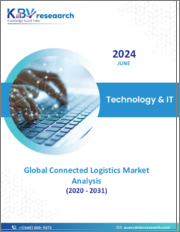
|
시장보고서
상품코드
1584554
물류용 AI 시장 평가 : 제공, 용도, 산업, 지역별 기회 및 예측(2017-2031년)AI in Logistics Market Assessment, By Offering, By Application, By Industry Vertical By Region, Opportunities and Forecast, 2017-2031F |
||||||
세계의 물류용 AI 시장 규모는 2023년 120억 2,000만 달러에서 예측 기간 중 CAGR 26.22%로 추이하며, 2031년에는 774억 3,000만 달러로 성장할 것으로 예측됩니다.
이 시장은 효율성, 비용 절감, 고객 서비스 향상에 대한 수요 증가로 인해 성장세를 보이고 있습니다. 기업은 머신러닝, 예측 분석, 자동화와 같은 AI 기술을 활용하여 공급망 운영을 최적화하고 효율적인 재고 관리 및 경로 계획을 개선하고 있습니다. 이러한 발전은 지연을 줄이고 운영 비용을 최소화하여 실시간 의사결정을 가능하게 하고, AI 기반 툴은 수요 예측을 용이하게 하여 기업이 시장 수요를 예측하고 전략을 조정할 수 있게 하며, IoT 장비와 AI를 통합하여 전체 공급망에 대한 가시성을 향상시킵니다. E-Commerce가 계속 성장함에 따라 물류 분야는 복잡한 배송 네트워크를 관리하고 더 빠른 서비스를 원하는 고객의 기대에 부응하기 위해 AI 솔루션을 도입하고 있으며, AI에 대한 투자는 물류 최적화를 통해 이산화탄소 배출량을 줄일 수 있습니다. 물류 최적화를 통해 이산화탄소 배출량을 줄일 수 있으므로 지속가능성의 필요성 때문에 AI에 대한 투자가 추진되고 있습니다. 전반적으로 물류에 AI를 도입하는 것은 빠르게 변화하는 시장 환경에 초점을 맞추면서 혁신과 경쟁력을 촉진할 수 있습니다.
세계의 물류용 AI 시장을 조사했으며, 시장의 정의와 개요, 시장 규모 추이·예측, 각종 구분·지역/주요 국가별 상세 분석, 산업 구조, 시장 성장에 대한 영향요인 분석, 사례 연구, 경쟁 구도, 주요 기업의 개요 등을 정리하여 전해드립니다.
목차
제1장 프로젝트 범위와 정의
제2장 조사 방법
제3장 개요
제4장 고객의 소리
- 제품과 시장 정보
- 브랜드 인지의 모드
- 구입 결정시 고려되는 요소
- 프라이버시와 규제에 관한 고려
제5장 세계의 물류용 AI 시장 전망
- 시장 규모 분석·예측
- 시장 점유율 분석·예측
- 제공별
- 용도별
- 산업별
- 지역별
- 기업 점유율 분석
- 마켓 맵 분석
제6장 북미의 물류용 AI 시장 전망
- 시장 규모 분석·예측
- 시장 점유율 분석·예측
- 국가별 시장 평가
- 미국
- 캐나다
- 멕시코
제7장 유럽의 물류용 AI 시장 전망
- 독일
- 프랑스
- 이탈리아
- 영국
- 러시아
- 네덜란드
- 스페인
- 터키
- 폴란드
제8장 아시아태평양의 물류용 AI 시장 전망
- 인도
- 중국
- 일본
- 호주
- 베트남
- 한국
- 인도네시아
- 필리핀
제9장 남미의 물류용 AI 시장 전망
- 브라질
- 아르헨티나
제10장 중동 및 아프리카의 물류용 AI 시장 전망
- 사우디아라비아
- UAE
- 남아프리카공화국
제11장 수급 분석
제12장 밸류체인 분석
제13장 Porter's Five Forces 분석
제14장 PESTLE 분석
제15장 시장 역학
- 시장 성장 촉진요인
- 시장이 해결해야 할 과제
제16장 시장 동향·개발
제17장 사례 연구
제18장 경쟁 구도
- 시장 리더 상위 5사의 경쟁 매트릭스
- 상위 5사의 SWOT 분석
- 주요 기업 상위 10사의 상황
- FourKites, Inc.
- Flexport, Inc.
- NVIDIA Corporation
- Vorto.
- Google LLC
- Logiwa, Inc.
- Coupa.
- Epicor Software Corporation
- Amazon Web Services, Inc.
- Tredence.Inc.
제19장 전략적 제안
제20장 Market Xcel - Markets and Data 소개·면책사항
KSA 24.11.15Global AI in logistics market is projected to witness a CAGR of 26.22% during the forecast period 2024-2031, growing from USD 12.02 billion in 2023 to USD 77.43 billion in 2031. The market is experiencing growth due to the increasing demand for efficiency, cost reduction, and improved customer service. Companies are leveraging AI technologies such as machine learning, predictive analytics, and automation to optimize supply chain operations, efficient inventory management, and improve route planning. These advancements enable real-time decision-making by reducing delays and minimizing operational costs. AI-powered tools facilitate demand forecasting, allowing businesses to anticipate market needs and adjust their strategies. Integrating AI with Internet of Things devices increases visibility across the supply chain and improves shipment and asset tracking. As e-commerce continues to expand, the logistics sector is increasingly adopting AI solutions to manage complex delivery networks and meet customer expectations for faster service. Investing in AI is promoted due to the need for sustainability because optimized logistics can reduce carbon dioxide emissions. As a whole, the recruitment of AI in logistics promotes innovation and competitiveness while focusing on the rapidly evolving market environment.
In June 2023, a Norwegian drone logistics company, Avant Global Limited, launched a home delivery service called Kyte, which operates within a 30 km radius to transport groceries, ready meals, and light medicines via its application. Aviant has demonstrated its capabilities by previously drawing USD 1.1 million in funding from Innovation Norway. The company aims to deliver prescription medicines to remote areas by leveraging drones to overcome mobility issues caused by bad roads and severe weather. This innovative approach enhances access to vital supplies and sets a precedent in the logistics market by proving that drone delivery can effectively operate over larger distances without traditional limitations, marking a significant advancement in AI-driven logistics solutions for last-mile delivery.
Technology and Automation to Drive Market Growth
Technology and automation are revolutionizing AI in the logistics market, dramatically increasing efficiency, accuracy, and scalability. Advanced AI algorithms analyze massive amounts of data to optimize supply chain processes, allowing companies to forecast demand, manage inventory, and optimize delivery routes in real-time. Automation technologies such as robotics and autonomous vehicles reduce human error and operational costs while accelerating warehouse operations and last-mile deliveries. IoT devices provide continuous monitoring of shipments, improving transparency and enabling proactive responses to disruptions. Machine learning models further improve logistics strategies by learning from historical data to aid in risk management and operational forecasting. The convergence of these technologies enables logistics companies to improve customer experience, reduce delivery times, and minimize environmental impact, contributing to overall industry growth. This synergistic effect of artificial intelligence, automation, and data analytics contributes to innovation and development by positioning them in a competitive environment.
In January 2024, Accenture and Mujin, Inc. launched a joint venture, Accenture Alpha Automation, to enhance the manufacturing and logistics sectors through AI and robotics. This collaboration combines Mujin's expertise in intelligent robotics with Accenture's digital engineering capabilities, enabling companies to integrate operational and management data for improved decision-making and hyper-automation. By simplifying the deployment of robotic systems, the venture addresses the complexities typically associated with industrial automation. This initiative not only enhances productivity and efficiency but also supports the growth of AI in the logistics market by fostering a data-driven approach, essential for navigating the challenges of an aging workforce and evolving market demands.
Cost Reduction to Fuel the AI in Logistics Market Growth
The reduction in costs associated with AI technologies significantly boosts growth in the logistics market by enhancing operational efficiency and decision-making. Lower implementation costs enable companies, even smaller ones, to adopt AI solutions such as predictive analytics and automated inventory management. This leads to optimized routes, reduced delivery times, and improved resource allocation, ultimately driving profitability. Cost-effective AI tools foster innovation, allowing logistics firms to experiment with new models and technologies. As a result, the logistics sector becomes more agile and responsive to market demands, contributing to a more dynamic and competitive environment.
In September 2023, FourKites, Inc. launched Fin AI, a groundbreaking generative AI solution designed to enhance supply chain visibility and decision-making. Utilizing the largest supply chain data network, Fin AI offers a natural language interface that helps companies quickly assess disruptions, diagnose shipment issues, and automate time-consuming tasks. By enabling proactive decision-making and eliminating data silos, Fin AI empowers logistics professionals to focus on high-value tasks, driving efficiency and optimization in areas such as transportation and inventory management. This innovation is poised to significantly advance AI integration in the logistics market, enabling companies to leverage vast amounts of data for smarter, faster decision-making, and ultimately fostering growth in the industry.
Retail Segment to Dominate the AI in Logistics Market Share
The retail sector dominates the logistics market for AI due to the high demand for effective supply chain management and improved customer experience. With the rise of e-commerce and increasing consumer expectations for fast and accurate delivery, retailers are using AI to optimize inventory, forecast demand, and automate order fulfillment. AI solutions such as robotics, predictive analytics, and autonomous delivery systems streamline operations and reduce costs. Retailers can benefit from AI-enhanced last-mile delivery and personalized customer service, which are essential to staying competitive in a rapidly evolving marketplace. This growing reliance on AI is driving the retail sector's leadership in the logistics industry's transformation.
In March 2023, Alibaba Cloud launched its AI-driven logistics solution, EasyDispatch, in Malaysia to enhance the local logistics industry by improving supply chain management and reducing costs. The solution features real-time service dispatch, advanced vehicle route planning, and high-accuracy address processing, leveraging reinforcement learning and machine learning. Collaborating with local companies Global Track and EasyParcel, Alibaba Cloud aims to elevate operational efficiency and scalability, helping businesses reduce processing times and workforce requirements significantly. This initiative is set to drive digital transformation in the logistics sector, fostering growth in the AI market by enabling smarter, data-driven decision-making and enhancing overall service delivery.
North America to Dominate AI in Logistics Market
North America is dominating the AI in logistics market due to its robust technological infrastructure, significant investment in research and development, and a concentration of leading tech companies. The region benefits from a highly skilled workforce and extensive data availability, facilitating the implementation of AI solutions for supply chain optimization, predictive analytics, and autonomous vehicles. The presence of major logistics firms and e-commerce giants drives demand for innovative AI applications, enhancing efficiency and reducing costs. Collaborative partnerships between technology providers and logistics companies further accelerate AI adoption, positioning North America as a leader in this transformative sector.
In May 2024, AB Volvo Autonomous Solutions recently unveiled Volvo VNL Autonomous, a fully redundant autonomous truck developed in partnership with Aurora Innovation, Inc., designed to enhance freight capacity and address industry challenges such as driver shortages. This truck integrates advanced safety features and cutting-edge autonomous driving technology, making it a significant step forward in logistics. Increasing efficiency and reliability in transport helps logistics companies scale operations and facilitates adopting AI-driven solutions across the industry, ultimately improving the supply chain and allowing human drivers to focus on tasks better aligned with work-life balance.
Future Market Scenario (2024 - 2031F)
AI enables more efficient supply chain management by forecasting demand, optimizing routes, and managing inventory levels in real time, reducing costs and improving service levels.
The rise of autonomous vehicles and AI-enabled drones will revolutionize last-mile delivery, increasing speed and reducing labor costs while improving customer satisfaction through faster service.
AI provides vehicle maintenance and equipment predictive analysis and identifies problems before leading to dysfunction, minimizing downtime and reducing dysfunction.
AI can contribute to more individual logistics solutions, provide individual distribution options, and improve monitoring and communication abilities to improve customer participation.
Key Players Landscape and Outlook
Companies in the global AI in logistics market are focused on improving efficiency and profitability through automation, predictive analytics, and real-time decision-making. They use AI to optimize routes, forecast demand, and automate warehouses, reduce delays, and improve supply chain visibility. The integration of AI-based robotics for material handling, packaging, and sorting is on the rise. Companies are investing in AI-based fleet management to monitor vehicle performance and reduce fuel consumption. By constantly improving machine learning algorithms and implementing IoT for real-time tracking, AI companies are addressing the growing need for fast, flexible, and sustainable logistics solutions.
In April 2024, The Coca-Cola Company and Microsoft announced a USD 1.1 billion five-year strategic partnership to leverage Microsoft's cloud and generative artificial intelligence technologies. The alliance is designed to strengthen Coca-Cola's technology strategy and focus on innovation and productivity across its global operations. This partnership investigates marketing, manufacturing, and supply chain AI applications to rationalize operations and improve customer experience using tools such as Azure OpenAI Service and Microsoft 365. This initiative enables the more effective management of supply chains, predictive analysis, and automation, greatly enhancing the logistics market, ultimately reducing costs and improving the response to market demands.
Table of Contents
1. Project Scope and Definitions
2. Research Methodology
3. Executive Summary
4. Voice of Customer
- 4.1. Product and Market Intelligence
- 4.2. Mode of Brand Awareness
- 4.3. Factors Considered in Purchase Decisions
- 4.3.1. Features and Other Value-Added Service
- 4.3.2. Efficiency and Speed
- 4.3.3. Cost Reduction
- 4.3.4. Flexibility and Scalability
- 4.4. Consideration of Privacy and Regulations
5. Global AI in Logistics Market Outlook, 2017-2031F
- 5.1. Market Size Analysis & Forecast
- 5.1.1. By Value
- 5.2. Market Share Analysis & Forecast
- 5.2.1. By Offering
- 5.2.1.1. Hardware
- 5.2.1.2. Software
- 5.2.1.3. Services
- 5.2.2. By Application
- 5.2.2.1. Inventory Control and Planning
- 5.2.2.2. Transport Network Design
- 5.2.2.3. Purchasing and Supply Management
- 5.2.2.4. Demand Planning and Forecasting
- 5.2.2.5. Others
- 5.2.3. By Industry Vertical
- 5.2.3.1. Automotive
- 5.2.3.2. Food and Beverages
- 5.2.3.3. Manufacturing
- 5.2.3.4. Healthcare
- 5.2.3.5. Retail
- 5.2.3.6. Others
- 5.2.4. By Region
- 5.2.4.1. North America
- 5.2.4.2. Europe
- 5.2.4.3. Asia-Pacific
- 5.2.4.4. South America
- 5.2.4.5. Middle East and Africa
- 5.2.5. By Company Market Share Analysis (Top 5 Companies and Others - By Value, 2023)
- 5.2.1. By Offering
- 5.3. Market Map Analysis, 2023
- 5.3.1. By Offering
- 5.3.2. By Application
- 5.3.3. By Industry Vertical
- 5.3.4. By Region
6. North America AI in Logistics Market Outlook, 2017-2031F*
- 6.1. Market Size Analysis & Forecast
- 6.1.1. By Value
- 6.2. Market Share Analysis & Forecast
- 6.2.1. By Offering
- 6.2.1.1. Hardware
- 6.2.1.2. Software
- 6.2.1.3. Services
- 6.2.2. By Application
- 6.2.2.1. Inventory Control and Planning
- 6.2.2.2. Transport Network Design
- 6.2.2.3. Purchasing and Supply Management
- 6.2.2.4. Demand Planning and Forecasting
- 6.2.2.5. Others
- 6.2.3. By Industry Vertical
- 6.2.3.1. Automotive
- 6.2.3.2. Food and Beverages
- 6.2.3.3. Manufacturing
- 6.2.3.4. Healthcare
- 6.2.3.5. Retail
- 6.2.3.6. Others
- 6.2.4. By Country Share
- 6.2.4.1. United States
- 6.2.4.2. Canada
- 6.2.4.3. Mexico
- 6.2.1. By Offering
- 6.3. Country Market Assessment
- 6.3.1. United States AI In Logistics Market Outlook, 2017-2031F*
- 6.3.1.1. Market Size Analysis & Forecast
- 6.3.1.1.1. By Value
- 6.3.1.2. Market Share Analysis & Forecast
- 6.3.1.2.1. By Offering
- 6.3.1.2.1.1. Hardware
- 6.3.1.2.1.2. Software
- 6.3.1.2.1.3. Services
- 6.3.1.2.2. By Application
- 6.3.1.2.2.1. Inventory Control and Planning
- 6.3.1.2.2.2. Transport Network Design
- 6.3.1.2.2.3. Purchasing and Supply Management
- 6.3.1.2.2.4. Demand Planning and Forecasting
- 6.3.1.2.2.5. Others
- 6.3.1.2.3. By Industry Vertical
- 6.3.1.2.3.1. Automotive
- 6.3.1.2.3.2. Food and Beverages
- 6.3.1.2.3.3. Manufacturing
- 6.3.1.2.3.4. Healthcare
- 6.3.1.2.3.5. Retail
- 6.3.1.2.3.6. Others
- 6.3.1.2.1. By Offering
- 6.3.1.1. Market Size Analysis & Forecast
- 6.3.2. Canada
- 6.3.3. Mexico
- 6.3.1. United States AI In Logistics Market Outlook, 2017-2031F*
All segments will be provided for all regions and countries covered
7. Europe AI in Logistics Market Outlook, 2017-2031F
- 7.1. Germany
- 7.2. France
- 7.3. Italy
- 7.4. United Kingdom
- 7.5. Russia
- 7.6. Netherlands
- 7.7. Spain
- 7.8. Turkey
- 7.9. Poland
8. Asia-Pacific AI in Logistics Market Outlook, 2017-2031F
- 8.1. India
- 8.2. China
- 8.3. Japan
- 8.4. Australia
- 8.5. Vietnam
- 8.6. South Korea
- 8.7. Indonesia
- 8.8. Philippines
9. South America AI in Logistics Market Outlook, 2017-2031F
- 9.1. Brazil
- 9.2. Argentina
10. Middle East and Africa AI in Logistics Market Outlook, 2017-2031F
- 10.1. Saudi Arabia
- 10.2. UAE
- 10.3. South Africa
11. Demand Supply Analysis
12. Value Chain Analysis
13. Porter's Five Forces Analysis
14. PESTLE Analysis
15. Market Dynamics
- 15.1. Market Drivers
- 15.2. Market Challenges
16. Market Trends and Developments
17. Case Studies
18. Competitive Landscape
- 18.1. Competition Matrix of Top 5 Market Leaders
- 18.2. SWOT Analysis for Top 5 Players
- 18.3. Key Players Landscape for Top 10 Market Players
- 18.3.1. FourKites, Inc.
- 18.3.1.1. Company Details
- 18.3.1.2. Key Management Personnel
- 18.3.1.3. Products and Services
- 18.3.1.4. Financials (As Reported)
- 18.3.1.5. Key Market Focus and Geographical Presence
- 18.3.1.6. Recent Developments/Collaborations/Partnerships/Mergers and Acquisition
- 18.3.2. Flexport, Inc.
- 18.3.3. NVIDIA Corporation
- 18.3.4. Vorto.
- 18.3.5. Google LLC
- 18.3.6. Logiwa, Inc.
- 18.3.7. Coupa.
- 18.3.8. Epicor Software Corporation
- 18.3.9. Amazon Web Services, Inc.
- 18.3.10. Tredence.Inc.
- 18.3.1. FourKites, Inc.
Companies mentioned above DO NOT hold any order as per market share and can be changed as per information available during research work.



















